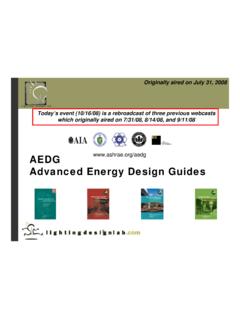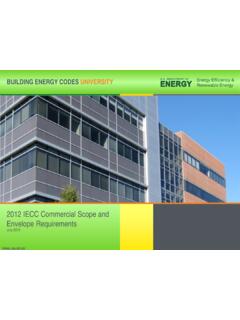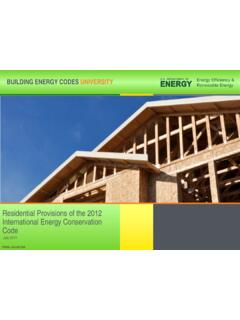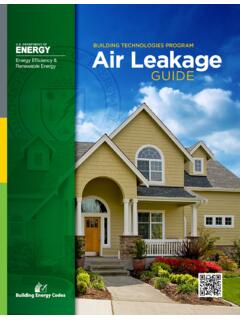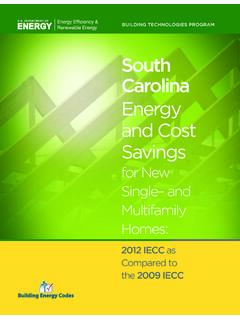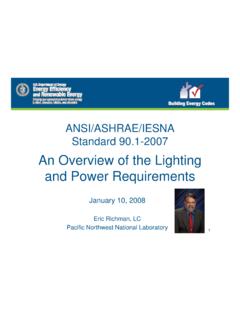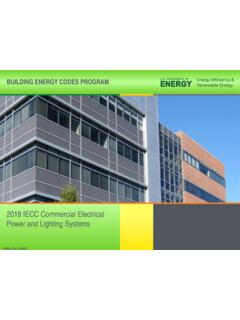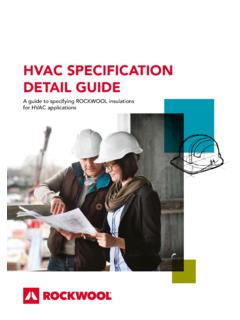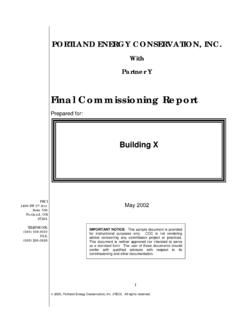Transcription of Open Spaces as Return-Air Options - Code Notes
1 Open Spaces as Return-Air Options - code Notes Stud cavities and floor joist Spaces are often used to return air to the heating, ventilating, and air conditioning ( hvac ). system#s air-handler, and are specifically allowed in the I-codes. Field testing shows that these return systems are often extremely leaky. Leaks within areas that include combustion appliances do not meet the code , and present potential health risks. Open Spaces in the building are often effective and inexpensive (for example, incorporating hallways as part of a Return-Air system).
2 Homes with basements often use wall studs and floor joist Spaces as Return-Air cavities. Extensive testing indicates that duct leakage in homes with basements are very high unless the ducts have been pressure tested and sealed under a beyond- code program (utility, state or local) that tests for duct tightness. In one random sample of 40 homes during 2000, over 60% of the leaks were located in the Return-Air ducts. In one-third of those homes, Return-Air leaks connected to the basement could create enough negative pressure that exhaust gases were at risk of being drafted back down water heater flues.
3 Some jurisdictions want every bedroom to have a Return-Air duct directly back to the hvac cabinet. Yet field measurements in typical homes indicate that second-floor Return-Air ducts relying on building cavities for air transport are often so leaky that they returned little air to the hvac blower. By code , building cavities used for air return can only convey air from one floor level back to the hvac blower (2006 and 2009 IRC #7). The 2009 IECC Section requires that duct systems be pressure tested, or all ducts and air handlers be located in conditioned space .
4 Building cavities used to convey return air located over a crawlspace or next to an unconditioned space would be required to be tested. As an inexpensive and effective alternative to sealing ducts, the code specifically allows air return by connecting rooms by permanent openings. For example, hallways can be part of the Return-Air path. Two generic approaches are identified that fit the code . Strategy #1, Suitable Method for Single-Story and Multi-Story Homes 1. Use either hard ducts or flex ducts for short, centralized returns that only pull air from central hallways and living zones.
5 (Flex ducts are easy to seal tightly, but are also vulnerable to flow restrictions.). 2. Any of the following is acceptable for pressure relief in bedrooms and dens with operable doors: Page 1 of 4. a pair of offset transfer-air grilles in room walls that connect to hallways, or other open Spaces directly linked to the central return short "jump ducts" (typically located in ceilings) that allow room air to flow back to hallways any method of pressure balancing that, during operation of the hvac blower, creates no more than a Pascal pressure difference across closed doors (amendment to the Florida code in 2003).
6 This may require a pressure test. Strategy #2, Preferred Method for Ranch-Style Homes One hvac ductwork concept incorporates a dropped ceiling. In a hallway ceiling that has already been finished with drywall, ductwork and under-framing are installed to create a long dropped ceiling, typically providing a 7-foot ceiling height the length of the hallway. The supply plenum and mini-runs are suspended Page 2 of 4. within the cavity; the rest of the dropped ceiling cavity carries return air from individual rooms back to the hvac air-handler.
7 (For more details, see articles cited in the Reference section.). Plan Review The plan review guidance for Strategy 1 assumes that mechanical plans have been submitted for permitting. If a mechanical plan is not submitted, compliance will need to be determined in the field. 1. Verify that the mechanical plan shows the location of the return and supply duct system, and the proposed cfm for each register. 2. Verify that the location of the jump ducts, offset transfer grilles, or pressure balancing strategy is shown on the plan.
8 3. Verify that the total unobstructed area for each transfer grille is specified on the plans. The grille area should be based on the total supply cfm for the room. 4. Verify that the return duct(s) back to the system is sized per manufacturer''s specification. Verify that the return duct locations are in centralized hallways or living zones, and not in a closet, bathroom, toilet room, kitchen, garage, mechanical room, furnace room, other dwelling unit, or a room containing a fuel burning appliance that draws its air from that exhaust air into that room (IRC 2000 Section and 2003.)
9 Section ). 5. Require that the construction detail show the proposed jump ducts, offset transfer grilles, or pressure balancing strategy. The plan review for Strategy 2 assumes that mechanical plans have been submitted for permitting. If a mechanical plan is not submitted, compliance will need to be determined in the field. 1. Verify that a mechanical plan has been submitted that shows the location of the return and supply duct system, and the proposed cfm for each register. 2. Verify that the total unobstructed area for each transfer grille is specified on the plans.
10 The grille area should be based on the total supply cfm for the room. 3. Require the construction detail to show the dropped ceiling detail, and how the supply duct will be suspended and supported in the dropped ceiling space . Field Inspection 1. If mechanical plans have been submitted, verify that the installed system matches the system shown on the approved building plans. 2. If mechanical plans have not been submitted, verify the following in the field: for Strategy 1, verify that a transfer grille or jump duct is installed for each sleeping room; also, verify that centralized returns are located in a hallway or living space for jump ducts, verify that the duct work is sealed for Strategy 2, verify that the dropped ceiling space was framed after the sheetrock was installed and taped in the hallway.
